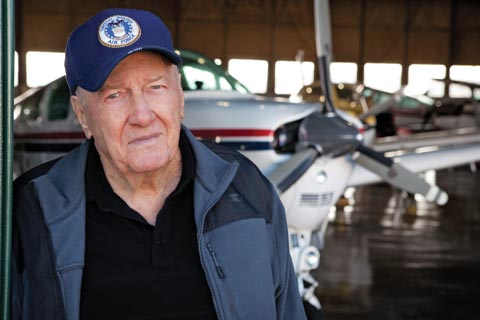Pilots:
Ralph Campbell

Ralph Campbell’s students laud a man whom they know as aviator, teacher, and friend. He is described as exacting, even demanding; effortless and precise on the controls—and usually sitting next to them with his arms loosely crossed, relaxed but observant.
At 88, Campbell still has the self-assurance and physical presence of a fighter pilot. Asked when he first knew he wanted to fly, he tells the “cat” story with a smile. When his cat died, the 2-year-old asked his mother where his pet had gone. “She pointed to an airplane that happened to be flying overhead. After that day, I always wanted to fly.” At his kitchen table, a half-mile from the Willoughby Lost Nation Airport east of Cleveland, Ohio, Campbell pulls out a lifetime of aviation memorabilia and recalls his war experiences.
Although trained as a fighter pilot, Campbell reported to the right seat of a Boeing B–17G just in time for his first mission on D-Day. He flew 35 bomber missions before eventually seeing combat in Lockheed P–38s as well. However, no war experience stands out more clearly to Campbell than July 31, 1944, a day on which his past, present, and future legacy were pieced together. The crew nursed the Hello Mr. Meier, a B–17G, back from Munich on two engines and a ruptured fuel supply and ditched in the North Sea. The nose slammed into a wave, and the cockpit rapidly flooded.
“John [the first pilot] and I reached across rising water and shook hands goodbye,” recalls Campbell. “Then, to our surprise, the water rushed out just as quickly as it rushed in, and we decided we better get out.” Finding his raft punctured by bullets, Campbell jumped into the oily water and was rescued an hour later.
Recuperating in a hospital the next day, Campbell was handed a telegram: “Dear daddy, announcing my arrival. Mother doing fine. Linda.” The telegram was sent via Western Union on July 31, 1944, at 9 p.m.
After the war, Campbell worked as an electrical engineer for a TV station in Cleveland and gave flight instruction on nights and weekends. He is now retired from work and flying. His daughter, Linda, and son, Bruce, live nearby.
Near Bury St. Edmunds, England, a monument marks the event that brought Campbell and his family together and gave his flight students a mentor. There, a Wright Cyclone with its bent propeller adorns a memorial to all who flew out of Rougham Field. A data plate reads: “The Hello Mr. Meier and the day it came to rest on the bottom of the North Sea—July 31, 1944.”
Photography by Don Bensman Jr.


